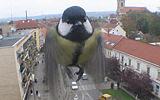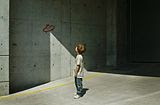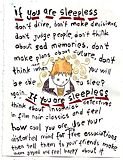Tuesday, September 25, 2012
How to Tune In to the Voice Within By Martha Beck
How to Tune In to the Voice Within
By Martha Beck
Following Your Inner Buddy
Exercise 1: WWBD?
Think of a challenging circumstance or difficult decision you happen to be facing right now—something that's been keeping you up at night. With this situation in mind, write the first answer that comes up when you ask yourself the following questions. Don't overthink the answers. In fact, don't think about the answers at all—just blurt.
With regard to your difficult situation...
What would calm do now?
What would peace do now?
What would relaxation do now?
(Note: I don't include "What would love do now?" because so many people have such misguided interpretations of love. They think love would sacrifice its own happiness, or throw a tantrum, or hide in an ex-boyfriend's garage wearing nothing but night-vision goggles and a leopard-print thong.)
The more often you ask yourself these strange questions, the more open you become to the gentle energy of your own inner wisdom. When you feel your body begin to let go of tension, you know you're headed in a wise direction.
And that's what Buddy would do.
Exercise 2: Nightmare Board, Wisdom Board
Perhaps you've heard of vision boards: collages you assemble from pictures of things that appeal to you. Most of us go through life carrying something similar in our minds—except that instead of pictures that appeal to us, they're crowded with pictures that torment and terrify us. I call these nightmare boards.
Your nightmare board, curated, assembled, and prominently displayed by your inner Fang, contains images of everything that frightens and upsets you, including all your most hideously painful experiences. Fang is continuously adding new pictures to the board and lovingly retouching the old ones.
Here's a radical assignment: Make your nightmare board real. Glue up some actual images of every frightening thought that haunts you. But don't stop there. When you're finished, you're going to make another board. This new board must contain three or more images that contradict every picture on the nightmare board. For example, if your nightmare board shows a devastating oil spill, your vision board might feature three photographs of people tenderly swabbing oil-coated ducks. For every image of violence, come up with three examples of loving kindness; for every crisis, find three beautiful, ordinary moments of calm.
When you're finished, ceremoniously shred, burn, or otherwise trash Fang's nightmare board. Then put your wisdom board where you can see it. Focusing on hope in a world of fear isn't naive. It's the irrational essence of wisdom.
Exercise 3: Vocab Rehab
Take ten minutes and write a description of your life—stream of consciousness, no self-judgment, no editing. Then go over your description, looking for every word that carries frightening or painful associations. These words have more power than you might think. Studies show that after focusing on words having to do with aging, people walk more slowly; when they see words associated with anger, they're more likely to be rude.
This phenomenon is called affective priming, but it works both ways. You can use it to connect with your inner wisdom by changing every stressful word in your self-description to something more freeing, relaxing, or exhilarating. If you wrote "I'm nervous," see whether "I'm excited" may also fit. The word unsure could be replaced by open. As you change your story, Fang's voice will begin to soften, and the peace that comes from your wiser inner voice will begin to arise.
Practice Makes Permanent
All these exercises can divert your attention from bossy, self-righteous Fang and help you appreciate the brilliance of your inner Buddy. Wisdom will never be the loud, obvious one in this odd couple. It will never shout down its opposition or barge in uninvited. But each time you choose wisdom as your adviser, you come closer to making the choice a way of life. Trust me, that's advice you want to take.
Martha Beck is the author of six books, including Steering by Starlight (Rodale).
Read more: http://www.oprah.com/spirit/Finding-Your-Inner-Voice-Developing-Intuition-Martha-Beck/3#ixzz27W8etJEo
Friday, September 21, 2012
Robert Genn on "The Fear of Missing Out"
Managing FOMO
September 21, 2012
Dear Sherrie,
"Fear of Missing Out," according to psychologists, is pandemic and getting worse. For us creative folks, FOMO is not just a social disorder, it can be a career killer.
More prevalent in younger people than older ones, it's that terrible feeling that you're missing out on something that might be better or more fun than what you're doing right now. Since the cellphone revolution, checking and texting can be based on a thin hope that something really wonderful is coming up. In life and art, it can be a false hope that keeps us checking.
And it's not just technology. Artists regularly move to the Big Apple hoping to take a Big Bite. With so much going on--openings and exhibitions every night, MOMA, Guggenheim, etc., to say nothing of the theatre scene--there's little time for work. Many artists function better in dull places like Sedro-Woolley, WA.
Addictive FOMO is a malaise that strikes close to home and particularly in the studio. If you think you've caught it, here are a few thoughts and findings:
Temptation preys on our extroverted nature and our optimistic outlook. Introverts and pessimists tend to be less troubled by it. To be truly productive, creative folks need to withdraw to privacy and self-sufficiency. In a beloved art-cave, work can triumph over outside distractions. In other words, the artist needs to look eagerly toward a satisfactory outcome of work-in-progress. Even quasi-satisfactory outcomes are superior to being stuck in traffic or watching pole dancers in a noisy cabaret. One's art needs to be personally elevated and seen as its own reward. When this happens, a marching band out the window cannot budge you from your self-appointed rounds.
Luckily, as we get older, we tend to be more settled and less likely to have our heads turned. The golden years can be highly productive. But we're all on the horns of a dilemma--connectivity and temptation are here to stay. FOMO researcher Sherry Turkle says, "Our current relationship with technology fosters immaturity." It's been my observation that the greatest generator of quality work rests within the development of personal character. Some of us need to grow up.
Best regards,
Robert
PS: "We just don't know until we check." (John M. Grohol, PsyD)
Esoterica: Here's a compromise system that accepts the current situation and goes a long way toward managing addictive FOMO. Not wanting to miss out what's going on in the world, you might try one of those tiny clip-on battery radios with earphones. As you move around your work area and beyond, the passive info goes with you. (I'm currently using the marvelously informative programs on CBC AM, 690 kHz, also available on satellite.) While it might sound like giving in to the devil, it's a good example of 21st Century mind expansion and multi-tracking that, while not diminishing creative focus, simply and effectively retards the temptation to step out the door and join the band.
Friday, September 14, 2012
A strange situation by Robert Genn
A strange situation
September 14, 2012
Dear Sherrie,
Recently, Patricia Godvin of Bozeman, Montana wrote, "As an artist who works with the nude figure, I find so little quality dialogue or artists' exchange of ideas concerning this subject. I would love you to stimulate some discussion on working with the unclothed figure."
Thanks, Patricia. Have you ever noticed that paintings of nudes come and go in popularity? In the galleries I work with, there are currently very few. Back in art school the nude was de riguer and I actually thought I was getting the hang of it. In those days, most of our models were women. Perhaps the current decline is because the idea of "woman as object" is not as popular as it once was.
I recently passed by a classroom full of women furiously drawing a nude guy. It seemed a comment on our times and a subject for a New Yorker cartoon.
Fact is, the unclothed figure, male or female, is an education in waiting. Above spheres, cones and blocks, the human figure is key to understanding light and form. Michelangelo went so far as to say, "One who does not master the nude cannot understand the principles of architecture." Student artists neglect figurative work at their peril. Painting or drawing nudes with facility was a rite of passage for past members of the Brotherhood and Sisterhood. Fortunately, underground vestiges of the cult still exist. "The naked form," said Auguste Rodin, "belongs to no particular moment in history; it is eternal, and can be looked upon with joy by the people in all ages."
Well, maybe not by all people in all ages. Whole cultures are currently trying to get more and more folks to cover up. Is the world turning once again toward some sort of Puritan modesty, equating skin with prurience and sin? Might this be partly because of recent Western art trends depicting naked depravity? Was, as some critics think, Toulouse Lautrec the naughty one who set the orgy in motion? Perhaps we might, within the anatomy of our imaginations, think once more of the naked body as a vessel of grace, taste and wonder. In the spotted history of art, stranger things have happened.
Best regards,
Robert
clicks.robertgenn.com/strange-situation.php
PS: "The body always expresses the spirit whose envelope it is. And for him who can see, the nude offers the richest meaning." (Auguste Rodin)
Esoterica: Our bodies, apart from their brilliant role as drawing exercises, are the temples of our being. Like the bodies of all fauna, they deserve both our study and our appreciation. Few there are who object to a naked dog, cat, horse or parakeet. The Society for the Encouragement of Modesty in Animals (SEMA) attracted only 72 members before its website went blank. I once considered a program to put shorts on dogs, but Dorothy rejected the garment and made an unpleasant fuss. There's something natural about au naturel. But when, for art's sake, will au naturel make its next comeback? "What is the body? That shadow of a shadow of your love that somehow contains the entire universe." (Rumi)
Monday, September 3, 2012
12 Pieces of Advice from the World's Best Writers Read more: http://www.oprah.com/spirit/Advice-from-the-Worlds-Best-Writers-Quotes-on-Writing#ixzz25RLHVtap
http://www.oprah.com/spirit/Advice-from-the-Worlds-Best-Writers-Quotes-on-Writing
These are some great quotes. A few just may inspire you!
Subscribe to:
Posts (Atom)









